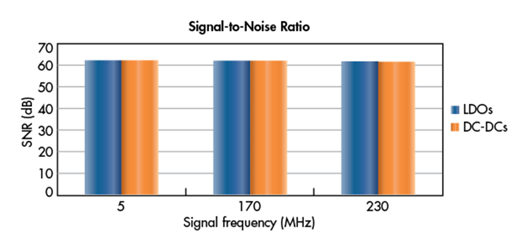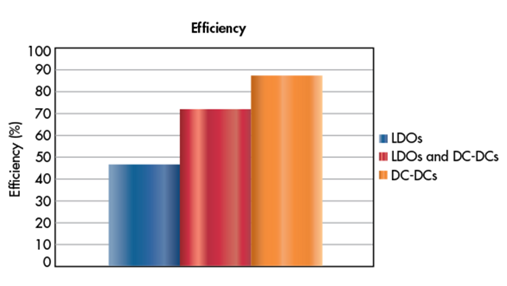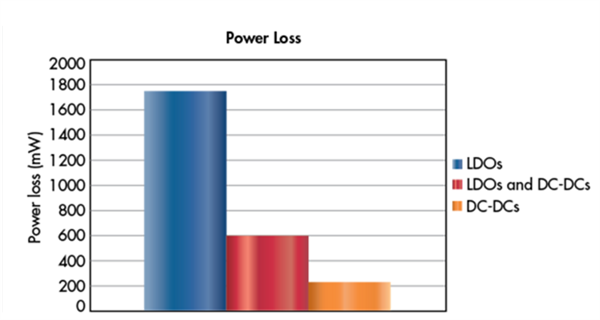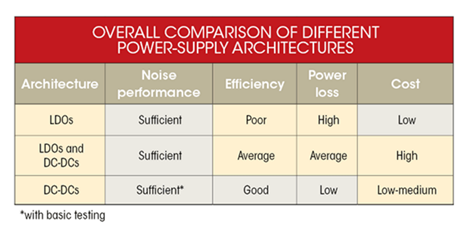SSZTAI7 december 2016 ADS5407
 Figure 1 SNR of the ADS5407 Powered by
LDOs or DC/DCs
Figure 1 SNR of the ADS5407 Powered by
LDOs or DC/DCsCan you tell the difference in the signal-to-noise (SNR) ratio shown in Figure 1? Neither can the ADS5407 12-bit analog-to-digital converter (ADC). Both the low-dropout (LDO) linear regulators and the step-down (buck) DC/DC converters give the same data converter noise performance. How is noise performance determined? Which power-supply architecture should you choose?
The TI Designs Efficient, LDO-Free Power Supply for a 12-Bit 500MSPS ADC Reference Design measures and compares the performance of the ADS5407 with each power supply. At a high level, an ADC’s performance is quantified by its SNR and spurious-free dynamic range (SFDR). These are the first measures of the ADS5407’s noise performance. A graphical user interface (GUI) is provided with the data converter evaluation module (EVM) to easily measure SNR and SFDR under user-defined conditions, such as data converter settings and input tone frequencies. These raw GUI measurements, taken at three different input frequencies, are found in the reference design’s test report. In addition to the SNR measurements shown above, Figure 2 shows the SFDR comparison.
 Figure 2 SFDR of the ADS5407 Powered by
LDOs or DC/DCs
Figure 2 SFDR of the ADS5407 Powered by
LDOs or DC/DCsIf both LDOs and DC/DCs give the same performance, why would you use one over the other? Shouldn’t you just pick whichever device is cheaper? While cost might be most important for some systems, efficiency is more important for other systems. For example, in battery-powered equipment, the inefficiency of LDOs reduces battery run time. In high-ambient-temperature systems, the heat created by the LDOs can reduce system reliability. Figure 3 shows the efficiency of different power architectures, while Figure 4 shows the corresponding power loss in absolute terms.
 Figure 3 Efficiency Comparison of
Different Power-supply Architectures
Figure 3 Efficiency Comparison of
Different Power-supply Architectures Figure 4 Power Loss Comparison of
Different Power-supply Architectures
Figure 4 Power Loss Comparison of
Different Power-supply ArchitecturesInstead of using an LDO such as the TPS79601 or a DC/DC such as the TPS62231, some customers use both. A DC/DC steps down the input voltage, and an LDO placed after the DC/DC filters out or cleans up whatever noise might be present. While this provides satisfactory performance for a data converter, it adds much cost and printed circuit board (PCB) space while only providing average overall efficiency. With the simple SNR and SFDR testing described in this post, you can remove the LDOs and eliminate their power loss from the system.
Table 1 compares all three power-supply architectures, while this paper contains more details about the testing.

|
Which do you prefer for your data converter: low-cost LDOs or efficient DC/DCs?